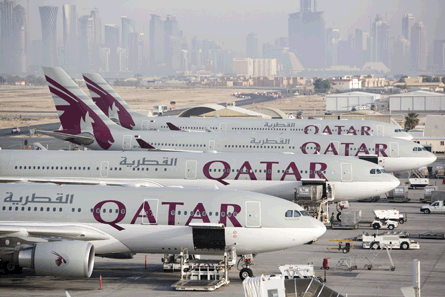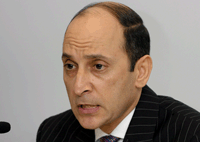It has been another frantic 12 months for Qatar Airways, as it continues to build its global network and add more capabilities to its airliner fleet.
This year is continuing in the same vein, with 15 more routes - including the first to South America - and around 18 new aircraft joining the fleet, as well as the likelihood of further big orders for replacement and expansion in short-haul operations.
Expansion and development of Qatar's capital, Doha, is continuing apace, with billions of dollars being invested in infrastructure and tourism. The bulk of the 1.6 million residents are from overseas, and the number will grow further as the country continues to work to attract more business.
By the middle of 2010, the Qartari flag carrier's destination count had reached 92 cities, while its airliner fleet numbered around 80 (including freighters but excluding business jets that are operated within the group). In its last financial year (to 30 March 2010) Qatar's passenger numbers grew by 20% to 14 million and this healthy double-digit growth is set continue. Next year will see its fleet and destination count pass the 100 mark.
 |
|---|
© Qatar AirwaysQatar is adding 15 routes - including the first to South America - and around 18 new aircraft this year |
The airline has added two more strings to bow, fleet-wise, in the last year - ultra-long-range and large-payload freight. The first of eight Boeing 777-200LRs arrived during 2010 and the ultra-long-range twinjets have been deployed on new non-stop Australian services to Melbourne.
Meanwhile, the cargo arm has just put the first of three 103t-payload 777Fs into service on routes to Europe and Asia from its freight hub in Doha, operating alongside three Airbus A300-600Fs.
By the end of next year, the airline expects to have begun receiving the first of 30 787s on order, while deliveries of 80 A350 XWBs should begin in the second half of 2013. The next step in the expansion plan could see an order for Bombardier's CSeries, and/or Airbus's proposed A320 "new engine option" before this year is out.
Qatar Airways has 10,000 employees (plus a further 5,000 group-wide) including around 1,500 pilots and 3,500 cabin crew, and these numbers will grow steadily as the airline expands, says chief executive Akbar Al Baker. "We'll be recruiting 2,500-3,000 more staff during our 2010-11 financial year."
 |
|---|
© Qatar Airways"We will capitalise on the growing trade and economic links with South America"Akbar Al BakerQatar Airways chief executive |
Al Baker says that the headcount must rise to cater for new equipment joining the fleet as well as the need for people to staff new stations as destinations come on line.
One of the regions from which Qatar Airways has many recruits is Europe, he adds: "This is not only because of the slowdown, but also because we offer better job security - European airlines hire and fire without realising that when the recovery comes after a slowdown you then have to find replacements for the people laid off."
Qatar's minimum requirement for its captains is 6,000h with at least 2,000h in command, of which 1,500h have to been on a jet and 500h on type. First officers must have at least 1,000h including 500h on type. The airline prefers applicants with a rating on one of the types in its fleet, which comprises A320 family, A330/A340 and 777.
By mid-year seven new destinations had already been added to Qatar's network during 2010, in Asia, Europe and South America. These comprised Ankara, Bengaluru (Bangalore), Barcelona, Buenos Aires, Copenhagen, Sao Paulo and Tokyo. Al Baker says services to another eight destinations will start before the end of the current financial year.
Qatar Airways already serves North America through New York, Houston and Washington DC, and Al Baker describes the addition of South American routes as the completion of its global jigsaw. "We will capitalise on the growing trade and economic links with South America and the Middle East, offering a convenient air bridge to the huge Lebanese and Japanese communities that live in South America," he says. "We also have a large South American community in the Middle East."
As the airline awaits the completion and opening of its all-new airport around two years from now, its current base is threatening to burst at the seams, but Al Baker says the pending new hub has not stopped investment in the current facilities. "With the pace at which Qatar Airways is growing, we must continue to invest in the airport until the new one opens."
A brand new arrivals terminal has been completed adjacent to the existing building, which frees up space, and the departures check-in area has been extended. "Qatar Airways is also opening a new hotel at the airport, aimed at corporate and leisure travellers, as well as transit passengers," says Al Baker.
 |
|---|
"We'll be recruiting 2,500-3,000 more staff during our 2010-11 financial year"Akbar Al BakerQatar Airways chief executive |
As the new airport becomes fully operational, Qatar will begin introduce the five A380 superjumbos it has on order.
But despite the strong growth, Qatar Airways has not been immune to the downturn and increasing competition in the region, which Al Baker admits has had a downward impact on yields. However, he has tackled this through "close control of costs".
There is a programme to make the most of the country's abundant deposits of natural gas - Qatar is estimated to have around 150 years of proven reserves. In October last year Qatar Airways completed the world's first revenue flight powered by gas-to-liquid kerosene and Shell and partner Qatar Petroleum are building a local GTL plant which should be producing one million tonnes annually from 2012.
The airline is hopeful that a 100% synthetic jet fuel will become a reality within four years. It has joined forces with Airbus and other partners in the "Qatar Advanced Biofuel Platform" that is aimed at producing biomass-to-liquid jet fuel.
So Qatar Airways may have huge growth plans, but Al Baker is clear in his intention to ensure that these do not add to the industry's environmental footprint and he believes these initiatives are a genuine path to the "much-talked-about, but less actioned, carbon-neutral growth".
Source: Flight International




















